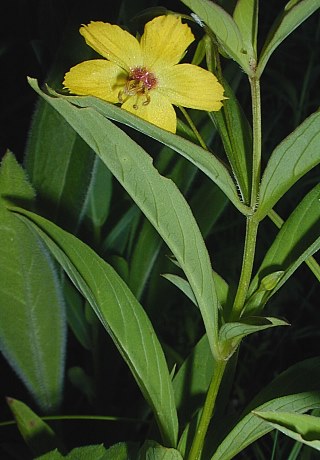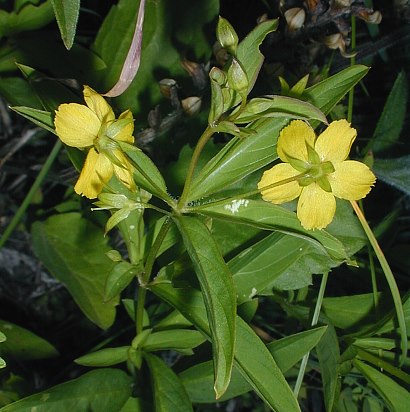Description: This herbaceous perennial plant is 1-2' tall and more or less erect. Initially, it consists of a rosette of leaves that are rather angular and orbicular. Later, a central stem develops that is 4-angled and smooth. The opposite leaves are up to 5" long and ¾" across. They are lanceolate or narrowly ovate, and often fold upward along the length of the central vein. Their margins are usually smooth (although sometimes ciliate), and there are no hairs, except toward the base of each leaf. These leaves are sessile against the stem, or they have short petioles with a few coarse hairs. The uppermost leaves at the top of a plant are usually whorled. The underside of each leaf is light or whitish green, but eventually becomes darker with age. There are a few short side stems in the upper half of the plant. From 1-4 nodding flowers develop from the upper axils of the leaves, each with its own pedicel. Each flower is about ¾" across, with 5 narrowly triangular green sepals, 5 yellow petals, and 5 yellowish orange stamens. The petals are well-rounded, but their outer edges are often ragged and may have conspicuous tips. Toward the center of the flower, there is a patch of orange surrounding the upper portion of the pistil. The blooming period occurs from early to mid-summer and lasts about a month. There is no noticeable fragrance. The flowers are replaced by spheroid capsules with slender spike-like tips. A fully developed capsule is about the same heighth as the surrounding sepals. The root system consists of a taproot and rhizomes that form little plantlets. This plant often forms small colonies by means of vegetative reproduction.

Cultivation:
The preference is partial to full sun, and moist to mesic conditions.
This plant usually grows in a loam or clay-loam soil, but it can
tolerate soil with sandy or rocky material as well. The foliage is
rarely bothered by disease; occasionally insects nibble the edges of
the leaves.
Range & Habitat:
The native Lance-Leaved Loosestrife occurs in most areas of Illinois,
except for a
few north-central counties and scattered counties elsewhere (see Distribution
Map). Although widely distributed, it is an occasional plant.
Habitats include moist to mesic black soil prairies, open woodlands,
thickets, swamps, gravelly seeps, limestone glades, and old fields with
hardpan clay or sandy soil.
Faunal Associations:
The flowers of the Lysimachia spp. (Yellow-Flowered
Loosestrifes) are unusual in that they produce a floral oil, rather
than nectar. Because of this, they attract the short-tongued Melittid
bee, Macropsis steironematis. This oligolectic bee
collects both the floral oil and pollen and forms a pollen-ball that
becomes the food of its developing bee-larvae. Otherwise, the flowers
attract few insects, except for the occasional visitor seeking pollen
from the anthers. Information about Lance-Leaved Loosestrife's relation
to birds and mammals does not appear to be readily accessible at the
present time.

Photographic
Location:
The photographs were taken at the Prospect Cemetery Prairie in Ford
County, Illinois, where there was a small colony of plants growing in
mesic black soil prairie.
Comments:
This plant would be more attractive to humans if the flowers did not
hang downward. The nodding characteristic of some flowers is often a
sign that the primary pollinators are bees, which are more willing to
hang upside down on the protruding structures of a flower in order to
obtain whatever food source they are seeking. This characteristic may
also protect the nectar or floral oil from rainfall. Lance-Leaved
Loosestrife can be distinguished from other loosestrifes primarily by
its opposite leaves, which are sessile or have very short petioles. The
height of the mature seed capsules is about the same as the height of
the surrounding calyx segments, while in other Lysimachia spp.
they are often unequal. The species Lysimachia hybrida,
which used to be considered a variety of Lance-Leaved Loosestrife, has
a similar appearance. However, Lysimachia hybrida
is supposed to have somewhat longer petioles, somewhat broader leaves,
and the undersides of its leaves are green rather than light or whitish
green, even in younger leaves.